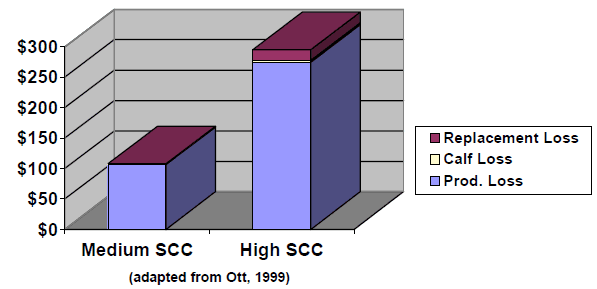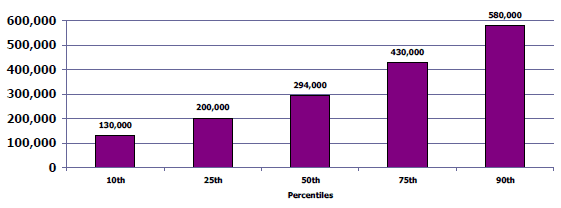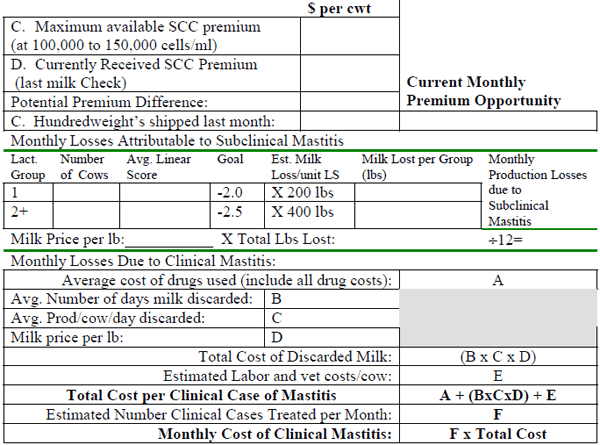Premiums, Production and Pails of Discarded Milk How Much Money Does Mastitis Cost You?
Published: July 30, 2012
By: Pamela L. Ruegg (University of Wisconsin)
Introduction
Profit centered dairy farms strive to maximize milk price and control costs. One way to control costs is by minimizing the rate of disease. The most costly disease of dairy cattle is generally considered to be mastitis. Mastitis can cause both clinical and subclinical disease. On many farms, subclinical mastitis is the most economically important type of mastitis because of the long-term effect of chronic infections on total milk yields. Persistent long-term infections with contagious pathogens (such as Strep agalactia and Staph aureus) damage milk secretory cells and result in reduced milk production. A recent study estimated that the cost of subclinical mastitis to the US dairy industry exceeds $1 billion annually. The effect of subclinical mastitis is shown in the somatic cell count (SCC) at the individual cow level and ultimately in the bulk tank. The SCC of cows infected with subclinical mastitis rises as the cows immune system sends white blood cells to the udder to fight off mastitis pathogens. The association between herd bulk tank SCC and production losses was recently compared between herds with low SCC (<200,000/ml), herds with medium SCC (200,000-399,999) and herds with high SCC (>400,000/ml), (Figure 1). The overall production loss for the average US dairy farm was estimated at $110/cow annually.
Figure 1. Production Losses Associated with Subclinical Mastitis

Higher bulk tank SCC levels are not considered desirable by most milk purchasers as high SCC reduces quality and yield of dairy products (such as cheese). Therefore, most milk purchasers pay premiums for higher quality milk. Controlling subclinical mastitis and producing lower SCC milk, therefore represents a potential profit opportunity associated with both increased production and increased milk price.
Figure 2. Distribution of Wisconsin Grade A Dairy Herd SCC, 1998

Through the adoption of standard mastitis control programs, many Wisconsin dairy herds have achieved a high level of control of contagious mastitis that is reflected in their bulk tank SCC (Figure 2). In 1998, the top 25% of Wisconsin dairy herds produced milk with an average bulk tank SCC of <200,000 and fully half of the herds (and a higher percentage of the milk) was produced by herds with an annual bulk tank SCC of less than 300,000/ml. Herds with low SCC may have minimized losses due to subclinical mastitis but still be incurring losses due to clinical mastitis. In these herds, milk yield losses attributable to clinical mastitis may be greater than that associated with high SCC.1 The primary mastitis pathogens are often environmental organisms such as E. coli and the environmental streptococci (Strep uberis and Strep dysgalactia).
This paper will review three primary cost centers attributable to mastitis and give individual farms a way to estimate and compare the profit opportunity of milk quality programs. A form adapted from work by Dr. Ken Nordlund will be introduced as a summary tool for on-farm use.
Premiums
Most milk purchasers prefer to purchase milk with low SCC and offer financial incentives to farmers for high quality milk. High SCC milk is not desirable for processors because it reduces the shelf life of dairy products and diminishes the quality and quantity of milk protein, thereby reducing cheese yields. Even modest increases in individual cow SCC (>100,000/ml) have been shown to reduce cheese yields. Quality premiums are a great opportunity for farmers to increase the marginal profit of their farms because they offer one of the few ways for farmers to significantly impact the price of milk that they receive. Farms that are not maximizing the opportunity that premiums offer may be missing an important source of income. There are 3 simple steps to calculate the potential opportunity from milk quality premiums (Table 1).
Table 1: Calculation of Milk Quality Premium Opportunity

The first step is to determine the maximum available SCC premium (Box A). Some premium programs continue to offer incentives down to a SCC level that is unrealistic for many farms (<100,000 cells/ml). If so, maximum available premium that is offered at 100,000-150,000 SCC may be used. The premium that the farm received on the last milk check is entered in box B and the potential premium difference can be calculated by subtracting B from A. Finally, the number of hundredweight's shipped last month is multiplied by the potential premium difference to obtain the current monthly premium opportunity. An example using a 50-cow dairy shipping 106,750lbs/month with a 450,000 cell count illustrates the process (Table 2):
Table 2: Example Calculation of Milk Quality Premium Opportunity

In this example, the 50-cow dairy was losing almost $1,000 per month in potential profit. Actual premium opportunity values from several Wisconsin farms are shown in Table 3:
Table 3: Milk Quality Premium Opportunity from Several Wisconsin Dairy Farms

Most of these farms can justify a considerable investment in milk quality programs, simply by the return of real dollars in quality premiums.
Production (subclinical mastitis)
Somatic cells in milk consist of white blood cells (WBC) and epithelial cells that are shed from the udder. When mastitis causing organisms infect the udder, the cow's immune system sends large number of WBC's to the udder to fight off the infection. The SCC in cows that do not develop mastitis is always less than 250,000 cells/ml. A SCC >250,000 indicates that the cow has a subclinical mastitis infection. The linear score (LS) is another way to measure SCC (Table 4). Research has shown that the linear score is highly related to loss of milk production in infected cows (Table 4).
Table 4: Relationship between SCC, Linear Scores and Milk Yield Loss

Milk production loss is the result of damage and chronic scarring of milk secretory tissue in the udder. Linear score data can be used to estimate milk production losses due to subclinical mastitis (Table 5).
Table 5: Estimated Production Losses Due to Subclinical Mastitis

The first step is to enter the number of first lactation and later lactation animals that are currently milking and the corresponding average linear scores (found on DHIA sheets) for each of those groups. Milk loss is estimated based upon the principle that each increased unit of LS greater than the goal accrues an annual loss of 200 lbs (first lactation) or 400 lbs (later lactation). First, the LS goal is subtracted from the actual LS and multiplied by the estimated milk loss to determine the milk lost per group. The total milk loss is then summed, multiplied by the current milk price and divided by 12 to determine the monthly production loss that can be attributed to subclinical mastitis. An example using a 100-cow herd with 50 first lactation (average LS of 4.0) and 50 older cows (average LS of 5.5) is shown in Table 6. A milk price of $14.00/cwt is used in this example. The difference between the average LS for heifers and the goal is 2.0 units (4.0-2.0). Multiplying 50 X 2.0 units X 200 lbs equal 20,000 lbs lost. The older cow milk lost is estimated by: 50 X 2.5 units X 400 lbs = 50,000 lbs. Therefore the total milk lost is estimated to be 70,000 lbs. The milk price per pound ($0.14) is then multiplied by 70,000 and divided by 12 months to estimate a monthly value.
Table 6: Example Calculation of Production Losses dues to Subclinical Mastitis

Actual subclinical production loss values from several Wisconsin farms are shown in Table 7:
Table 7: Subclinical Production Losses from Several Wisconsin Dairy Farms

Improvements in subclinical mastitis are not always as immediate or apparent as opportunities from quality premiums. However, it is apparent that considerable improvement in production is possible by limiting the number of subclinical mastitis infections.
Pails of Discarded Milk (clinical mastitis)
The final primary cost center for mastitis is financial losses attributable to clinical mastitis. The cost of clinical mastitis is often difficult to determine because the definition of a clinical case varies among milkers and between farms, treatment protocols vary and many farms do not routinely record the number of clinical cases that occur. The largest proportional cost of clinical cases is typically discarded milk (Figure 3).
Figure 3: Estimated Partial Cost per Case of Clinical Mastitis on Several WI Dairy Farms

The calculations of losses attributable to clinical mastitis usually require making some rough estimates of some of the input values. More accurate cost accounting can be performed by actually collecting records of the input data required to compute costs. The first step is to enter the average cost of drugs (including oxytocin and fluid costs) used to treat a clinical case (Table 8).
Table 8: Calculation of Cost of Clinical Mastitis

Next the cost of discarded milk is calculated by multiplying the pounds of milk discarded by the milk price per lb (lines B, C and D). Estimated labor and veterinary costs are then added to determine the total cost per clinical case. Finally, to determine the total monthly loss, the number of clinical cases is multiplied by the cost per clinical case. An example with real farm data is shown in Table 9:
Table 9: Example Calculation of Cost of Clinical Mastitis

On many dairies the cost of discarded milk can be a considerable, hidden cost of clinical mastitis. Cows that are chronically infected and treated repeatedly may contribute less milk to the bulk tank than to the drainage lagoon! Keeping records of the number of clinical mastitis cases and the number of days discarded can be important in optimizing profit.
Total Mastitis Losses
Lost premium opportunities, decreased milk production and discarded pails of milk are only a partial accounting of the total actual cost of mastitis on most dairy farms. Mastitis causes additional losses due to death, culling, decreased genetic gain and reductions in reproductive efficiency. These additional costs are often difficult to quantify on an individual working farm. The computations given in this paper can be used in a partial budget format to determine where the best opportunity for return on investments in milk quality lie. It is also important to recognize that the old maxim "garbage in, garbage out" applies very much to these estimates. Accuracy of on-farm estimates of the financial opportunity related to milk quality will be greatly enhanced by on-farm records of clinical mastitis and monthly SCC testing.
APPENDIX 1: FINANCIAL OPPORTUNITY ASSOCIATED WITH MILK QUALITY

References
1. Barbano, DM, Rasmussen RR, and Lynch JM. 1991. Influence of milk SCC and milk age on cheese yield. J Dairy Sci 74:369-388.
2. Deluyker, HA, Gay JM., and Weaver, LD. 1993. Interrelations of somatic cell count, mastitis and milk yield in a low somatic cell count herd. J Dairy Sci 76:3445-3452.
3. Lam, T.J.G.M., Berkem, H.W., Dopfer, et al.. 1997. Usefulness of recording clinical mastitis episodes. PP 113-118 in Proceedings of the 36th annual meeting of National Mastitis Council, Albuquerque NM. Natl. Mast Coun. Madison WI.
4. Ott, S. Costs of herd-level production losses associated with subclinical mastitis in US Dairy Cows. 1999. PP 152-156 in Proceedings of the 38th annual meeting of National Mastitis Council, Arlington VA. Natl. Mast Coun. Madison WI.
5. Raubertas, RF and Shook, GE. 1982. Relationship between lactation measures of somatic cell concentration and milk yield. J Dairy Sci. 65:419
6. White GC. Couture, GW., Anderson EO et al, 1937. Chronic bovine mastitis and milk yield. J Dairy Sci 20:171-180.
This article was originally published on the Milk Quality, University of Wisconsin´s website. http://milkquality.wisc.edu/. Engormix.com thanks for this huge contribution.
Related topics:
Authors:

Recommend
Comment
Share

Would you like to discuss another topic? Create a new post to engage with experts in the community.
Featured users in Dairy Cattle

José Manuel Oropeza Meza
MSD - Merck Animal Health
Gerente Nacional Cuentas Clave en MSD Salud Animal
United States
United States







